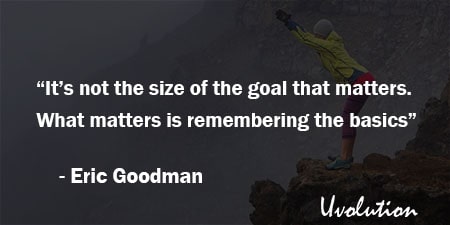True to Form by Eric Goodman Book Summary
The Book in 1 Sentences
True to Form: How to Use Foundation Training for Sustained Pain Relief and Everyday Fitness
“It took some time and much trial and error, but in the process I recognized something so fundamental, so essentially obvious that it has taken me a decade of practice and study to sort it out.
We move wrong.
More specifically, we move in ways contrary to how our bodies are naturally constructed and equipped for us to move. Many of us endure chronic pain precisely because we do not understand how to live correctly inside the efficiently designed bodies we are born into.
We aren’t given an operating manual and for some reason, our instincts have failed us.
This book sets out to change all that.
It all starts with the bodies we have and what we’re doing with them.” ~ Eric Goodman
8 BIG Ideas
True to Form Book Summary
1. Against gravity!
“The fact is that our physiology, whether sitting, standing, or on the move, is ideally suited to
push back against gravity—and in so doing, to decompress, unfurl, and elongate jammed bodies and experience all the vital power and flexibility of which those bodies are inherently capable.
The solution for this modern plague of compression goes right back to the basics of how our
bodies work, which is why I call it Foundation Training.”
“The human body is designed to thrive against gravity – else we tend to age rapidly and get injured. Foundation Training is the answer to my many years of research on the negative effects of sitting. It is a ticket to discover a more vibrant healthy life – no matter your age.”
“It stands to reason that if we can return our bodies to the physiological foundation we all started out with, we can recover the capabilities the foundation promised and perhaps reverse the adverse effects of the neglect.
That is the aim of Foundation Training, and it works in two ways:
one, through decompression movements that unwind and elongate the body to please the pent-up pressures of a body that has insufficiently resisted gravity;
and two, through anchoring movements that strengthen the body’s ability to hold itself upright and propel itself with stability and flexibility through various planes and axes of movement.”
2. How to optimize our posture?
“Their posture—that is, the way they held themselves structurally and the way they moved
muscularly—fitted that need: Movement was initiated at the hip joint, the body’s natural pivot point and therefore the most efficient and effective way to launch oneself into action;
torsos were extended and sternums high to accommodate the breathing that filled the lungs sufficiently to power the needed movement; and the body was elongated so these hunter-gatherers could see as far as possible from atop long, straight necks while being supported from the arches of their feet upward.
Possessing a structural integrity that could deliver stability and flexibility in equal measure, the body could be held in balance and moved for maximum results for a relatively minimal expenditure of energy.
These structural attributes produced a survival differential significant enough to win the reproduction lottery down through the generations. Codified in our DNA, the structure has been the foundation of human physiology ever since.”
The key is the ideal posture: “chest up, chin down.”
“Don’t shrug or hike up your shoulders; instead, raise your sternum, letting the breath of the inhalation lift your ribcage upward...”
Check out the book, there are a lot of illustrations to show us how to optimize our posture and how to perform the foundation training.
3. Decompression breathing
“The chapter is about breathing because it is the essence of decompression and therefore is
also the crucial element in these decompression exercises. A body compressed and grown rigid under gravity’s pressure is a body in which proper respiration has been stunted, effectively reigning in every move the body makes and every stand it takes.
Only lungs that are inflated to their oxygenated holding capacity are capable of empowering the appendicular skeleton to do everything it is capable of doing, and only a ribcage as big and wide as it can get can ensure that kind of lung power.
These exercises are aimed therefore at reeducating the axial skeleton into an expansiveness that enables accurate, effective breathing—in effect, retraining the pulley systems around the ribcage to give that structure its maximum mechanical advantage, making it as big and wide as it can be so that the lungs can do their job successfully. It’s as simple as that.”
Check out the core movement Eric calls “The Founder.”
Eric says: “To me, there’s a kind of magic in decompression breathing, although it’s a pretty straightforward matter of biomechanical science.
Standing tall against gravity by expanding the ribcage and filling your lungs with air is the gateway to everything else in the body’s natural posture of strength and flexibility.
When the ribcage is as big as it can be all the way around, chances are good that you’re long and strong in the torso, with an axial skeleton elongated from the tailbone to the skull. Everything is supported.”
“Focus on keeping your chest big. Again, picture your lungs: They are balloons within your ribcage, and you want to fill them up. Your chest’s inhalation circumference is the measure of this, so fill your lungs high and wide and watch the chest get bigger and bigger.
Hold that circumference on the exhale, keeping your chest big as you recruit those muscles
below the ribcage to maintain support.”
4. Intensity Vs Consistency
“They say you can’t really claim fluency in a foreign language until you’ve dreamed in the
language—in other words, until it’s lodged in your subconscious.
The metaphor works for Foundation Training as well: You can only claim that your body is
decompressed and anchored when the movements and postures of the exercises in this book have become absolutely automatic, when you’re no longer ‘translating’ in your head how to hold yourself and move right. You’re doing it right without thinking about it—unconsciously if not subconsciously.”
“It cannot be stressed too often or too strongly that restoring your body’s natural strength and flexibility comes not through intensity of effort but through consistency.
The body responds to how well and how persistently the postures and movements of Foundation Training are performed, not to how hard you do them.”
“High-frequency, low intensity, habitual, stop-and-start activities throughout the day are the path to health. They make the most of gravity, and by their very nature include limitless varieties of movements that benefit your whole body.”
“It cannot be stressed too often or too strongly that restoring your body’s natural strength and flexibility comes not through intensity of effort but through consistency.”
“Paleontologits surmise that Pleistocene men and women were upright and on the move
for most daylight hours, walking and/or running from five to ten miles per day.”
5. Set 20 minutes timer!
“There’s a simple solution. At least every 30 minutes—every 20 minutes is preferable—stand up.
Don’t just stand up, either; take a break from work. That is, do something else—something other than work—and what I am going to suggest is a 3-minute decompression routine that will pull your torso up, anchor your pelvis from below, and decompress you.”
6. Be like "the postage stamp"!
“‘Consider the postage stamp,’ someone once said; ‘it secures success through its ability to
stick to one thing till it gets where it’s going.’ Similarly, this initial retraining of your body’s
foundation depends on your own stick-to-itiveness in repeating small daily doses.
But in the first ninety days of doing so—a mere three months—you will achieve a substantive re-patterning of your body’s postures and movements, and you will feel the difference in your own strength and flexibility. ...
It’s not the size of the goal that matters. What matters is remembering the basics—now, later, throughout the day, tomorrow: to lift your torso as you pull your axial skeleton up, support the hips with as many muscles as you can, grip the ground with your feet, widen your ribcage and fill it with every breath, and in the words of Dr. Tim Brown, my mentor and friend, always to ‘Stand tall.’”
ALWAYS remember that “To get the process going, start small, stay basic, and do it every day.”
That was my QUICK summary of the great book True to Form by Eric Goodman. If you’re interested, get your copy. There is a HUGE amount of life-changing ideas in this book, and we’ve only touched on a tiny bit of it.
Buy The Book: True to Form by Eric Goodman

GET Blinkist 7 Days FREE Trial
3000+ Book Summaries
(Audio and Text)








